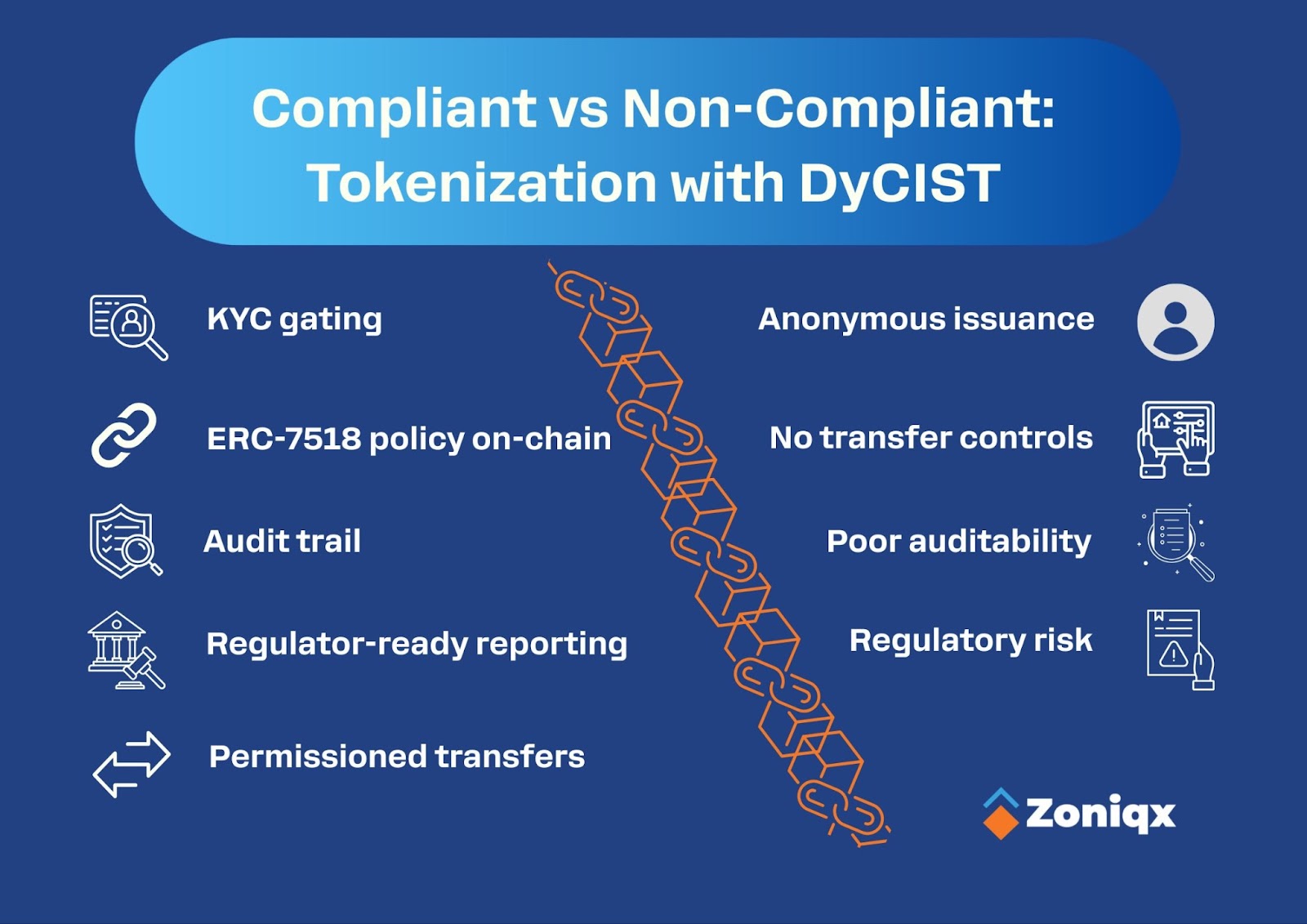How DyCIST Ensures Compliance in Asset Tokenization
Compliant tokenization is now table stakes for institutions issuing or trading digital assets. Regulators worldwide are creating clear rules for identity, disclosure and market integrity, and token design must follow. DyCIST embeds compliance into the token itself via the DyCIST ERC-7518 standard so tokenized products behave like regulated financial instruments.
What is DyCIST?
DyCIST is Zoniqx’s compliance-first framework for asset tokenization. It integrates identity, policy and audit controls directly with token lifecycle events to provide reliable blockchain compliance for issuers and custodians. This lets legal teams and auditors treat tokens as regulator-ready instruments while preserving on-chain innovation.
DyCIST’s ERC-7518 standard
The DyCIST ERC-7518 standard extends common token patterns by adding structured compliance metadata and policy enforcement hooks. Key capabilities include on-chain KYC/KYB flags, role-based permissions (issuers, custodians, auditors), and standardized audit hooks that trigger immutable logs and regulator notifications when required. By encoding governance and transfer rules in a single, portable token standard, ERC-7518 reduces the operational gap between code and legal obligations.
SEC Alignment (U.S.)
For U.S.-based issuers and platforms, DyCIST incorporates features to align with applicable Securities and Exchange Commission (SEC) regulations and guidance.
- Securities Act of 1933: ERC-7518 supports embedded transfer restrictions to comply with Rule 144 resale limitations and registration exemptions such as Regulation D or Regulation S.
- Securities Exchange Act of 1934: Standardized audit hooks and immutable transfer logs assist with ongoing reporting, insider trading controls, and broker-dealer recordkeeping obligations.
- Investment Company Act of 1940: For tokenized funds, DyCIST’s governance rules can enforce investment limits, redemption gates, and eligibility checks to maintain compliance with fund structuring rules.
- AML/KYC Requirements: While AML rules primarily stem from the Bank Secrecy Act and FinCEN guidance, DyCIST’s on-chain KYC/KYB metadata ensures the identity framework satisfies both SEC and broader financial crime compliance expectations.
By mapping token behavior directly to these SEC frameworks, DyCIST reduces legal uncertainty and enables regulated U.S. market entry without extensive manual enforcement.
Regulatory alignment (Global)
DyCIST is designed to map onto major regulatory frameworks so token issuers can operate cross-border with fewer rewrites:
- MiCA (EU): DyCIST supports issuer disclosure, recordkeeping and transfer restrictions called for under MiCA.
- VARA (Dubai): VARA’s virtual assets regime requires governance, AML/KYC procedures and operator licensing; DyCIST’s enforced identity and audit layers align with those responsibilities.
- DLT frameworks (ADGM / DIFC examples): DyCIST’s audit and custody primitives fit ADGM’s digital-securities treatment and DLT rulebooks for permissioned issuance and supervisory review.
These alignments let issuers reduce legal friction and prepare token products for regulated markets.
Example: DyCIST protecting a tokenized fund
A regulated fund issued with DyCIST might follow this flow:
- Issue: Fund tokens minted with investor KYC/KYB status embedded.
- Gate: Smart contract whitelists only approved wallets.
- Tranche controls: Lockup and distribution rules enforced at transfer time.
- Secondary-market restrictions: Jurisdictional and investor-type filters block non-compliant trades.
- Audit & reporting: Every transfer writes an immutable audit record; periodic snapshots and regulator hooks support reporting.
This stepwise approach keeps the fund auditable and reduces manual compliance work.
Why institutions care
- Lower regulatory risk: On-chain enforcement prevents accidental breaches.
- Faster audits: Standardized logs and hooks mean audits are quicker and cheaper.
- Market access: Compliant tokens ease listing and cross-border distribution.

References
- SEC — Securities Act of 1933: https://www.sec.gov/statutes/securities-act-1933
- SEC — Securities Exchange Act of 1934: https://www.sec.gov/statutes/securities-exchange-act-1934
- SEC — Investment Company Act of 1940: https://www.sec.gov/statutes/investment-company-act-1940
- SEC — Token guidance (Framework for "Investment Contract" Analysis of Digital Assets): https://www.sec.gov/corpfin/framework-investment-contract-analysis-digital-assets
- Regulation (EU) 2023/1114 (MiCA) — EUR-Lex: https://eur-lex.europa.eu/eli/reg/2023/1114/oj/eng.
- European Commission — Crypto-assets (MiCA overview): https://finance.ec.europa.eu/digital-finance/crypto-assets_en.
- VARA (Virtual Assets Regulatory Authority) — https://www.vara.ae/en/.
- VARA — About VARA: https://www.vara.ae/en/about-vara/.
- ADGM — Regulatory treatment of digital securities / DLT pages: https://en.adgm.thomsonreuters.com/rulebook/regulatory-treatment-digital-securities.
Disclaimer
This article is for informational purposes only and does not constitute legal, financial, or regulatory advice. Readers should consult qualified advisors before undertaking related activities.
About Zoniqx
Zoniqx, a Silicon Valley-based fintech leader, specializes in real-world asset tokenization using AI-driven multi-chain technology. Its platform ensures secure, compliant tokenization, supporting diverse asset classes and global liquidity.
To explore how Zoniqx can assist your organization in unlocking the potential of tokenized assets or to discuss potential partnerships and collaborations, please visit our contact page.
.jpg)


